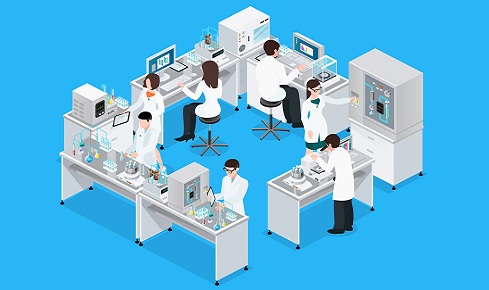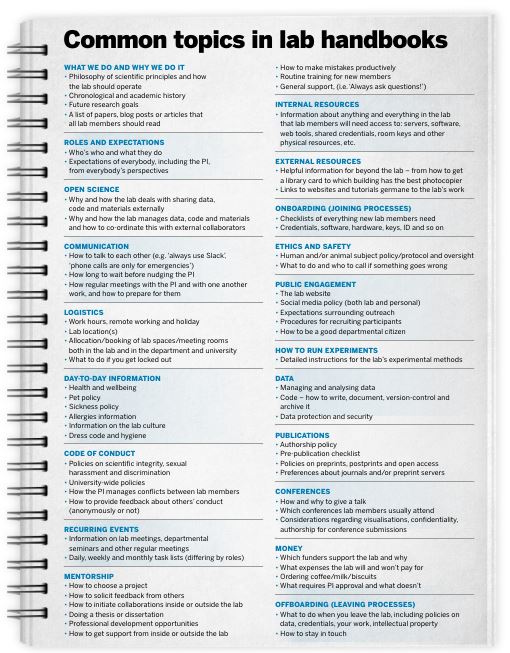How to… write a lab handbook

Samuel Mehr has studied what makes a good lab handbook so you don’t have to – and says a good one could improve your team’s science and save time
April 2nd 2020
When joining a laboratory, trainees become part of a scientific organisation with an array of expectations, goals, practices and rules, all of which evolve as the organisation evolves and together help to define its ethos. How do people take in all this information?
It’s a difficult time to be a scientific trainee[1,2], so when I started a laboratory of my own I wanted to support my team with clear and consistent information about how and why we work the way we do. Taking a page from other early-career principal investigators[3], I aimed to create a centralised set of expectations, policies, practical information and more, and make this all common knowledge to my students by writing a lab handbook. To get started I asked a few colleagues about theirs.
The answers were varied. Some had extensively documented laboratory policies, with carefully thought-out codes of conduct and detailed statements of scientific philosophy, but didn’t say much about how lab members should communicate with one another. Others focused on methods, with evocative descriptions of experimental techniques perfect for training new students, but didn’t cover the basics of day-to-day operations. And some said their labs worked perfectly well with no documentation at all. This made sense: after all, every laboratory has a different set of needs. But with a brand-new lab, I didn’t yet know what our needs were or where to begin with our handbook.
What goes in a handbook?
Borrowing from my lab’s corpus research approaches[4], I gathered about 25 lab handbooks and summarised their contents. I made a rough categorisation of the resulting topics – a sort of meta-handbook with minimally overlapping topics – and tweeted it. The thread and surrounding discussion, which generated additional topics that I had missed, has been viewed well over a million times.
The point of this exercise was not to provide a standardised template that all PIs should use to write a lab handbook. Rather, it helped me to lay out for myself the feature space of what might be of use to myself and my students in a lab handbook in principle. Armed with this information I could make informed decisions about how to design what would become my laboratory’s primary information repository: our fundamental policies and practices, our ideals for lab culture, and permanent documentation of the resources my students and I use on a regular basis.
What was in this meta-handbook? The 20 topics and associated content examples, summarised from my Twitter thread, are in ‘Common topics in lab handbooks’, below. These topics cover different types of information of use for any lab member in any scientific role.
What we put in ours
To begin writing, I chose the topics that were most important to my lab’s particular needs. Many of our projects involve asynchronous collaborations across time zones, so I devoted substantial thought to policies for communication and project management. For example, we do not use email, favouring Slack for communication and Trello for organising tasks. And while I wrote plenty of instructions on how to run our experiments, I left out high-level technical details of our web-based platform for data collection, which were only germane to the work of a few lab members, not the entire group.
Once I had finished a skeletal handbook, a few primary students and I worked together to fill it out. When we completed the first full draft we invited the rest of the lab to comment and add to it. This taught us what made sense to readers (and what didn’t), what sections were being read and ignored (and thus what sections we needed to update, re-emphasise or remove), and what we had forgotten to write.
The result is a ‘living document: we make minor edits and additions on an ongoing basis (tracking changes via GitBook, a version-controlled documentation system), and plan to revisit and edit it as a group each year. A public version is available here.
Why bother?
All of this, of course, took time and effort. After finding our sea legs over my laboratory’s first year of operation, we spent weeks of thought and effort writing and rewriting our handbook. Should every lab do this?
I don’t know and it’s not my place to advise. If anything, our experience demonstrates that lab handbooks are idiosyncratic. Our handbook doesn’t include all the topics from the table below, since not all of them matter to us. I suspect that the content of an ideal handbook depends on the research being done, the management style of the PI, the size and scope of the lab, how long team members stay, how often new people are trained, and so on. And if a lab functions perfectly well without one, bravo.
What our handbook did for us
That being said, there are a few key reasons that I’m happy with how this has worked out. Our handbook creates common knowledge about everything we do. All new laboratory members are required to read the handbook in detail, ask any clarifying questions as they go and, once they’ve finished, they state publicly, in writing, that they’ve done so. This means that when problems inevitably arise, we can safely assume a common understanding of our policies and procedures, helping us to work out those problems fairly. This protects everyone. For example, our procedures for determining authorship on papers are laid out before projects even begin, helping to avoid notoriously sticky disagreements.
It saves time. It includes checklists for recurring tasks, instructions for training new students, and information that we would otherwise be trying to remember, storing haphazardly or forgetting entirely. We use our handbook daily to circumvent ‘recipe drift’, a phenomenon I experienced working in a restaurant kitchen: inconsistent practices that result from a telephone game of ‘Alice told me to do it this way, but I used a shortcut; that’s how I taught Bob to do it, but he prefers this other thing…’. This lets us spend our time thinking about more interesting things and, I hope, improves the quality of our science. But at a more basic level, I think our handbook sends a simple and positive message to trainees: we have invested considerable time and effort in a resource that will make your lives easier.
Our handbook forced us to think about how we want to work. Rather than playing things by ear and hoping things work out for the best, writing it led to reasoned decisions about operations. The discussions leading to these decisions were an opportunity for disagreement and revision, yielding clear rationales for why we do things the way we do. For example, we collaboratively developed a set of policies for data management and security, arriving at the decision to move all our data and materials from a haphazard mix of storage methods to a GitHub Organization account, implementing version control for all our work.
I don’t know whether and how our experience will generalise to other laboratories, but we’re quite happy with the result and hope that the information here is useful.
Acknowledgements: Thanks to my current and former trainees S Atwood, C Bainbridge and M Bertolo (who co-wrote our handbook), and to J Kominsky, for their feedback on this piece.
Samuel Mehr is a research associate at Harvard University studying the psychology of music. You can read and participate in his lab’s research at www.themusiclab.org and he is on Twitter @samuelmehr
1) The mental health of PhD researchers demands urgent attention. Nature 575, 257–258 (2019).
2) Evans, T. M. et al. Evidence for a mental health crisis in graduate education. Nat. Biotechnol. 36, 282–284 (2018).
3) Aly, M. The key to a happy lab life is in the manual. Nature 561, 7 (2018).
4) Mehr, S. A. et al. Universality and diversity in human song. Science 366 (2019).



